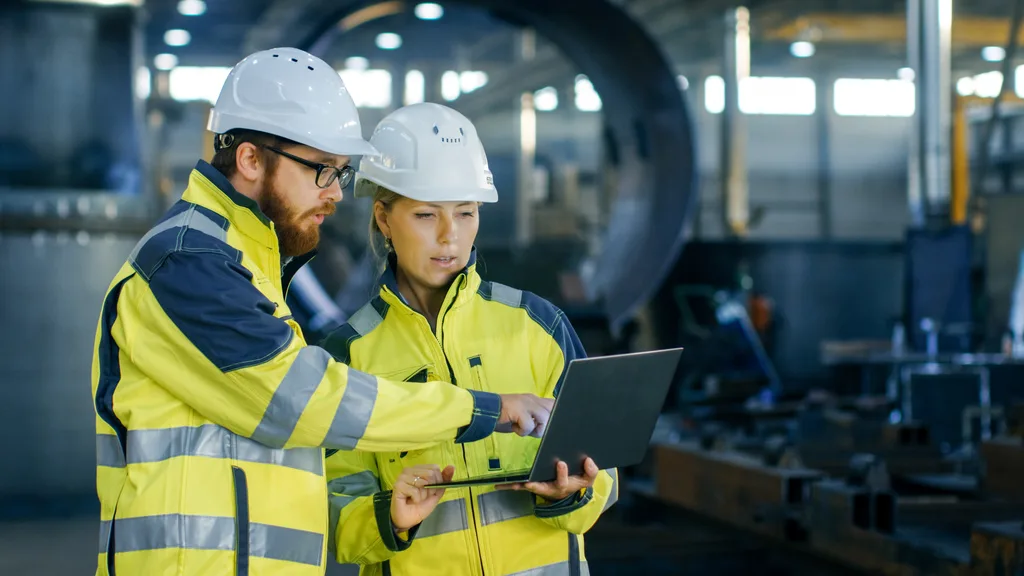The rise of smart systems
Smart and connected technology is playing an increasingly vital role in improving safety, providing better visibility and more effective management of airborne hazards in a wide range of setting. Becca Dodds provides an insight.

AI AND digitalisation are playing an increasingly important and prominent role in transforming how businesses approach workplace health and safety, reshaping approaches and offering new and innovative ways of working. As a result, we’re seeing the rise of businesses adopting such technologies to create safer, more efficient, and healthier work environments.
Staying connected
The field of gas detection is a good example of an area of safety in which smart and connected technology is playing an increasingly vital role in improving safety, providing better visibility and more effective management of airborne hazards in a wide range of settings, from cleantech to utility industries, oil and gas to manufacturing.
In environments where gas leaks pose a risk to site safety, the use of a connected and smart safety system offers continual monitoring of airborne hazards, with the potential to connect both area and portable systems, effectively creating one integrated, smart system.
These advances in technology improve the communication between devices and offer significant enhancements to safeguarding personnel and facilities by enabling crucial safety information to be displayed immediately via an online, cloud-based dashboard. This information can be accessed by anyone with the appropriate permissions, from anywhere, at any time. As a result, workers on site or managers in a remote or central location can pinpoint the position of colleagues and the gas safety status of the environment in which they are working at any given moment, while also protecting the workers’ privacy. This functionality means that the system better manages the risks posed by airborne hazards.
For example, at a wastewater site, there may be multiple engineers undertaking tasks which expose them to different hazards from gases such as methane or hydrogen sulphide. It is standard practice for all engineers to carry portable gas safety devices to alert them to immediate risks. Smart safety technology allows all these individual devices, as well as area gas monitoring devices, to create a single connected smart network. This enables gas alarms or potential air quality issues in any part of the site to be identified and acted upon as they arise.
Emails can also be set to be automatically sent to nominated contacts in the event of certain gas safety or air quality events.
Furthermore, live information can also be shared with the emergency services in the event of an incident to facilitate better response times and more effective treatment of patients (as they can see what those involved have been exposed to and the length of the exposure).
Adapting to changing working practices
The benefits of having a connected system become even more important when we consider changing working practices and the increase in lone working, particularly in the utility and energy sectors. In these situations, where solo personnel may be working remotely without direct supervision or where there are no colleagues in the immediate vicinity available to help if something goes wrong, the gas safety risks, along with the workers’ personal safety, are more pronounced, and a connected gas safety system is not just helpful, but a vital part of keeping colleagues safe and providing the workforce peace of mind.
By adopting smart technology, once an alarm is activated by any single gas monitoring device, colleagues and managers are immediately alerted to the risk, and receive key information displayed on the management dashboard which allows rapid and thorough assessment of the risks, and the ability to react quickly and appropriately.
Meanwhile, all data is logged for later compliance, analysis, and to enable learnings and allow data-driven decisions to enhance safety, helping to prevent future incidents.
Data can save lives
Collecting and evaluating all relevant information not only increases the safety of employees but also the safety of the entire facility. All data contributes to a holistic overview that allows organisations to:
- Recognise hazards from the operator’s position early on
- Initiate countermeasures more quickly, for example giving paramedics visibility of both the type of exposure and the severity
- Analyse correlations and anomalies more easily
- Identify causes more precisely and support the development of rectification plans.
- And as a result, enable proactive safety measures to be taken sooner and more effectively
An additional advantage of such systems is that asset management becomes more efficient and cost effective as each device is linked to a central control, allowing the calibration, test and sensor status of equipment to be assessed centrally.
Furthermore, any device can be easily added to the platform at any stage, for example if a site or operation is extended, or a new site added on. Plus, a ‘Smart Config’ feature allows for all the portable gas detection devices to be updated to a new configuration by setting up the template, and then the next time each device is docked in the calibration station, the new configuration will be automatically transferred to the device.
This enables far easier and more flexible management of equipment safety and operational efficiencies using, for example, predictive maintenance. It is also particularly useful when updates are needed when there are changes to legislation regarding permissible gas limits or changes in business processes or requirements, for example, motionless detection can be enabled, if this becomes a legal requirement in future.
Embracing the potential of technology
The use of AI and connected technology is well supported in safety management. Almost half (44%) of those involved in independent research undertaken as part of this year’s Dräger Safety and Health at Work report said they felt that new smart technology provides the opportunity to enhance workplace safety by reducing human error through automating repetitive safety checks.
This year’s report recognised that the technology involved in remote monitoring safety systems –which we discussed earlier in this article in relation to gas monitoring – offers huge potential. It’s also recognised that such advancements challenge some of the existing assumptions about issues such as the siting of large processing factories or other energy facilities. With advances in digital and connected technologies, it may be possible, for example, to take large processing factories away from heavily populated areas.
The research also supported that, at a fundamental level, better and more connected technology, as well as better user interfaces, offer the potential to make safety easier. Easier for managers or those with overall safety responsibility to monitor the workforce and more quickly identify potential issues, and easier for colleagues to be alerted to hazards in the vicinity in which they are working.
However, caution and balance around technology and AI in workplace safety are crucial, with 92% reporting that they see potential risks with AI technology in the field of workplace safety in the next five years. The most commonly mentioned concerns are an over-reliance on the technology leading to complacency in safety practices (47%), and the possibility that it will lead to job losses (43%), as well as privacy concerns related to employee monitoring (39%), technical failures or malfunctions in critical safety systems (38%), misinterpretation of AI-generated safety data (36 per cent) and resistance to change from employees (36%).
Addressing data and privacy concerns
As highlighted above, a common query around smart technology is the issue of data protection and cyber security, and this is where reliability and proven track record is essential. In the case of Dräger Gas Detection Connect, the use of the Microsoft Azure cloud platform, which adheres to strict standards of data protection.
Dräger also commissions an independent cyber security firm to carry out frequent penetration tests (PEN Tests) as well as conducting these in-house to maximise the security. Additionally, all software updates and support functions are included in the licence, and the platform is significantly reducing the IT input required by customers.
In addition, a range of measures have been incorporated to ensure the protection and security of customers’ data, while allowing each organisation the ability to set who can view which information. This includes the decoupling of location information from each user’s personal data after one hour if no alarm event has taken place, plus high security standards naturally apply to access options, including encryption and configuration of the devices.
While we have focused here on the application of smart technology to detect and manage airborne hazards and gas safety, an area which is become increasingly sophisticated in light of the increasing use of gases, such as hydrogen for clean energy applications, this is only one example of AI and smart technology being used to improve the safety of the workforce. Other areas which are seeing rapid advancements include smart PPE which allow managers to monitor compliance and potential risks being faced by employees operating in the oil and gas, or manufacturing industries in real time; predictive analysis where AI can identify potential safety risks and allow for proactive intervention and virtual reality training simulations which can provide an opportunity to practice hazards scenarios in a safe setting.
One thing which is clear is that smart technology and AI have a central role to play in workplace safety of the future, with new innovations being introduced all the time. For those who operate in this space, we need to ensure that we clearly communicate, educate and inform to address any concerns from employers or employees, and clearly demonstrate the significant value and benefits offered by these new advancements in safety technology.
Becca Dodds is marketing manager of portable gas detection at Draeger Safety UK. For more information, visit www.draeger.com
HSM publishes a weekly eNewsletter, delivering a carefully chosen selection of the latest stories straight to your inbox.
Subscribe here





